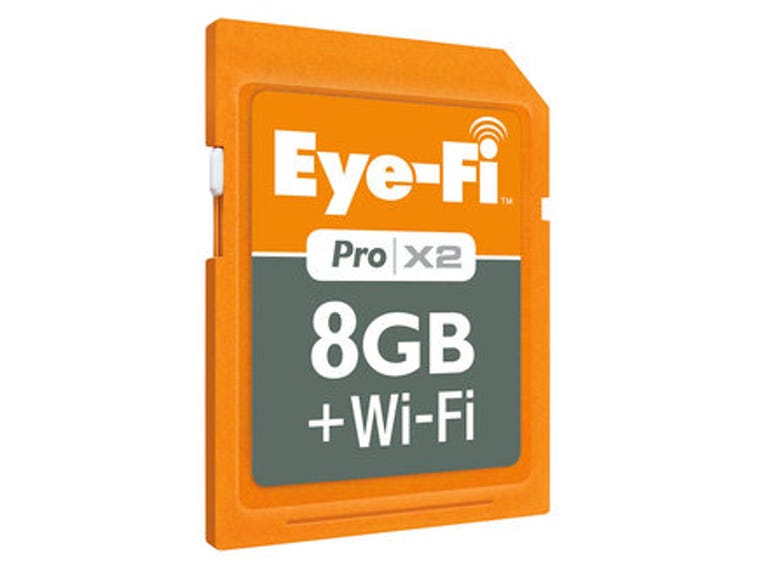 Why You Can Trust CNET
Why You Can Trust CNET Eye-Fi Pro X2 review: Eye-Fi Pro X2
The Pro X2 is an 8GB SDHC memory card with Wi-Fi capability. Whack it in a compatible camera and you'll be able to upload photos to your computer via a wireless connection. It works well, the included software is easy to use, and it could save you a great deal of time. It doesn't come cheap though
The Eye-Fi Pro X2 is a Wi-Fi-enabled SDHC memory card. Pop it in your camera and you can transfer your pictures to your computer via a wireless connection at home or a local hotspot. The 8GB X2 is the latest model in the Eye-Fi range, and adds a few new features, such as the ability to transfer images via ad-hoc networks, and the option to upload raw images. At £120, it's a serious investment, though, so does the Wi-Fi capability justify the price?
The Good
The Bad
The Bottom Line
Choose your assignment
To use the X2's wireless functionality, you'll need to assign the card to a wireless network. We found this process quite simple. The X2 comes with a USB card reader and, to get started, you'll need to attach this to your computer with the X2 inserted. The card comes pre-loaded with the software you need, and, once it's installed, you'll be taken through the set-up process. This involves finding your local Wi-Fi network, and assigning the X2 to that connection.
Once a connection is assigned, you can use the X2 in your camera just as you would a normal memory card. Take a picture, and the Eye-Fi Helper software on your computer will pick up any photos you've taken and begin uploading them.

You can select the destination folder for uploaded images using the Eye-Fi Center software
Because the photos you take are stored in the X2's 8GB of memory, the card is able to work through any backlog of photos that develops, so you don't have to worry about waiting for an image to upload before snapping a new one. We found that uploading a 12-megapixel image took around 15 seconds over a 24Mbps connection, so don't expect your photos to pop up on your computer instantaneously.
Class of its own
The X2 is a Class 6 memory card, so you'll get a minimum data-transfer speed of 6Mbps, and higher if your device can support it. That means you'll get a decent write speed using the X2 -- the less time it takes to write data to the memory card, the more time you can spend snapping.
There are several configurations you can use when uploading from the X2. The 'endless memory' mode will clear space on your card as needed, by deleting uploaded content once the memory has filled up to a pre-defined point. Users can change the point at which the X2 starts clearing space by adjusting a slider in the software settings. We had no problems using this feature, although whether you'll really find it that useful is something you'll have to decide for yourself -- when using this mode, you lose the security of having your images stored on both your PC and memory card.
The X2 also allows you to transfer files over an ad-hoc network, using your computer's wireless signal rather than a wireless router. This is useful if you're looking to take shots somewhere where there's no wireless connection. Using an ad-hoc network yields similar results to uploading over a proper network, although the set-up process is more difficult, because the software won't help you -- you'll need to set up an ad-hoc network on your computer yourself. That said, Eye-Fi does provide some online guidance to setting up an ad-hoc network and connecting the X2.
Eye-Fi with my little eye
Not all cameras will support the X2, as it's an SDHC card. Eye-Fi provides a compatibility check on its Web site, although we found there were some compatible and non-compatible cameras missing from the list -- the Panasonic Lumix DMC-FP3 and Nikon Coolpix S3000 among them. If you're thinking of buying the X2, we recommend contacting Eye-Fi to make sure your camera is compatible.
At £120, the X2 is probably too expensive for all but the most devoted hobbyist photographers -- a normal memory card and cable will probably serve your needs just as well. For professional snappers, however, the X2 is an entirely different proposition. If you're working in a studio, the convenience and security of having your images backed up as you take them will make the X2 a very tempting proposition. Also, if you're a professional on the road, the ad-hoc-network capability will have a similar allure.
Professionals will appreciate the X2's ability to transfer raw image files too. The only downside we can see is that 8GB might not be enough space for a professional photo jockey -- a full day's shooting of high-quality photographs will quickly eat through that storage space.
Conclusion
The Pro X2 may be the most expensive Eye-Fi card to date, but its extra features make it highly appealing. Uploading images over an ad-hoc network, the endless-memory mode and a nippy write speed are all welcome additions. While £120 is probably more than hobbyist photographers will be willing to spend, professional photographers would do well to check out the X2. On the other hand, if Wi-Fi isn't your bag, you'll do fine with just a normal high-capacity memory card.
Edited by Charles Kloet


